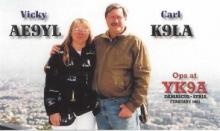A Survey of K9LA’s Propagation-Focused Web Site
A Survey of K9LA’s Propagation-Focused Web Site

By Carl Luetzelschwab K9LA
Editor's Note: Carl K9LA is a long-time amateur radio operator, DXer, electrical engineer, writer, and HamSCI member. He curates a tremendous amount of propagation and radio science information at his website, k9la.us. We have asked Carl to give us a brief tour of some of his favorite parts of his website.
If you’ve come to https://k9la.us because of your interest in propagation, the following is a mini-guided tour to help you navigate to the material you’re interested in.
The home page gives a basic introduction, and new items and relevant old items are listed here (usually at the beginning of each month). On the left side of the home page are links that contain material specific to certain aspects of propagation in our Amateur Radio hobby.
The Monthly Feature link offers articles about a myriad of topics. These topics are often tied to observations of ionospheric propagation and measurements of solar and ionospheric data. Some important topics that have been covered are the new sunspot numbers (the April 2016 document), the ongoing study of gravity waves and travelling ionospheric disturbances (the March 2020 document) and a look at propagation on our 630-meter and 2200-meter bands (the December 2018 document). As a side note, many HamSCI participants are involved in the gravity wave/TIDs studies.
The Timely Topics link has articles tied to recent happenings. It includes a plot of the latest smoothed sunspot number during the ongoing solar minimum period compared to previous solar minimum periods, and a plot of Cycle 24 and Cycle 25 sunspots as we progress through the solar minimum period between Cycles 24 and 25.
The Basic Concepts link highlights topics that provide a better understanding of several fundamental issues in propagation. Two such articles that are tied to propagation predictions are the correlation between solar flux and sunspot number, and the correlation between MUF and solar flux.
The Tutorials link provides information on how to set up, run and interpret propagation predictions with two free propagation prediction programs – VOACAP and W6ELProp.
The General link includes topics that are common to our MF and HF bands. Included are four of the five books that Bob NM7M (SK) wrote: Long-Path Propagation (1992 – a year-long study of long path on the 20-meter band from Anacortes, Washington to Europe and Africa), The Little Pistol’s Guide to HF Propagation (1996 – an intermediate level text about solar issues and propagation), Long-Path Propagation Revisited in Year 2000 (2000 – a broader look at long path, including processes affecting the 160-meter band) and On Ion Chemistry and Propagation (2002 – unpublished – a look about the very complicated chemical processes in the ionosphere). Also included in this link are articles on why our propagation predictions use a monthly median model of the ionosphere and not a daily model (the Day-to-Day Variability of the Ionosphere document), an article about two important magnetic field parameters (the Where Do the K and A Indices Come From document) and an article about high latitude propagation (the A Look Inside the Auroral Oval document).
The next three links are tied to specific issues for 160m, HF and VHF propagation. The 160m link has NM7M’s fifth book – The Big Gun’s Guide to Low-Band Propagation (2002 – a detailed look at propagation on the 160-meter band) and discussions about ducting, spotlight propagation and skewed paths on topband.
The HF link includes articles on propagation on our HF bands (many 10-meter articles and a discussion of an ionosphere-ionosphere mode on 20-meters).
The VHF link focuses on 6-meter propagation. Included in this link is an in-depth study on trans-equatorial propagation (common to our 6-meter and 10-meter bands).
The last link for propagation issues is the Contesting link. These are articles for contesting aficionados, and include using trees for low band wire antennas, the effect of solar flares on contest operations and the effect of CMEs on contest operations.
In summary, I hope there is something for everyone on my website with respect to LF, MF, HF and VHF propagation and solar topics. If not, let me know at k9la@arrl.net.
